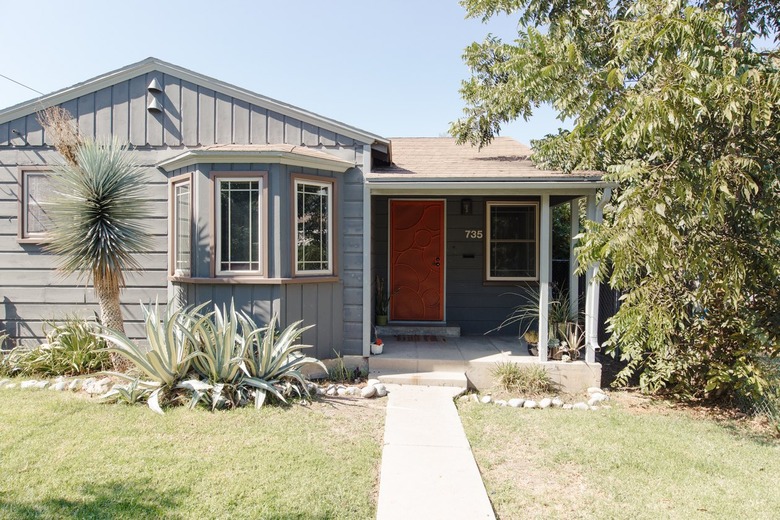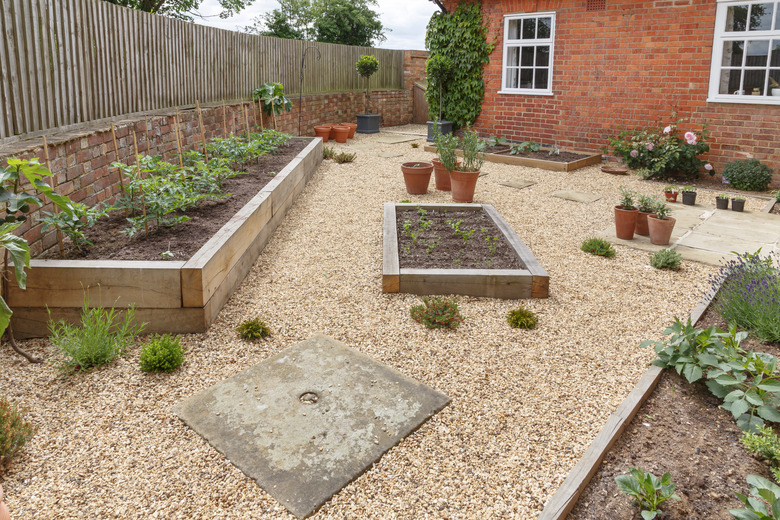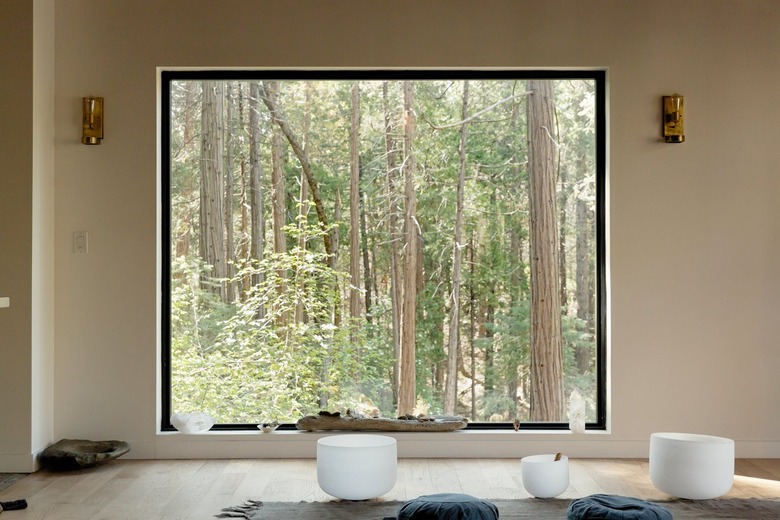Strategies For Making Your Home Safer And More Wildfire-Resistant
We may receive a commission on purchases made from links.
If you live in an area where wildfires pose a threat, it's important to make your property as fire-resistant as possible — especially during wildfire season when it's hot and dry outside. Although there are, of course, important steps you can take to protect your home itself, properly maintaining and preparing the area around your home can hopefully stop the fire from making it inside at all.
This is best achieved by creating a defensible space around your home. Defensible space is the 100-foot area around your house. Properly preparing and maintaining this zone means making sure you're not giving wildfires an easy pathway from the surrounding area to your home. There are no guarantees with a wildfire, of course, but you'll hopefully sleep a little better knowing that you did everything you could to protect your property.
Protect the House Itself
Protect the House Itself
Today, many homebuilders in wildfire-prone areas build houses using fire-resistant materials. If yours wasn't, there are still plenty of things you can do to protect the structure. One is to periodically check your roof and tack down any loose shingles you may see. Embers fly during wildfires, and it's often these embers that ignite houses. Keeping your roof well maintained will prevent embers from finding their way under loose shingles.
Window screens are also crucial to wildfire safety. During a wildfire, the temperature around the flames can become hot enough to shatter a home's windows. The broken windows then create an opening through which embers can enter the home and ignite it. Quality metal window screens can help keep out the embers.
Screens are also an important tool for covering open vents. Be sure to cover your home's vents with wire mesh or screening when installing your window screens. Ideally, screening and vent covers should be made of a metal 1/16-inch to 1/8-inch mesh. Don't use fiberglass or plastic screening, as these may melt, and they are combustible.
While you're screening, look up under the eaves of your roof. Roof eaves are the parts of the roof that hang out over the exterior wall a few inches. If you can see wooden beams, you have what builders call "open eaves." Screen them in and install angle flashing on the edge of your roof. Flashing at the edge of the roof will help prevent embers from blowing up under the roof edge and gaining entrance to the attic.
You'll also want to clean your gutters regularly. Pine needles, dead leaves and other gutter debris are quite flammable and potentially dangerous during a wildfire. If you don't already have them, consider installing gutter guards to minimize the amount of debris your gutters collect. Installing gutter guards is fairly simple and makes a good weekend DIY project.
Last but not least, always make sure you install a highly visible house number on your home. This is often overlooked, but it's a simple thing to do and can save critical time during a wildfire. If you need help evacuating or if firefighters have a chance to try and save your home, it's crucial for them to easily find the right house.
Protect the Surrounding Areas of Your House
Protect the Surrounding Areas of Your House
When making a home more fire-resistant, the areas just outside the house need some attention. Build any decks or porches from fire-resistant materials when you can. If your siding or other home exterior material isn't fire-resistant, install metal flashing on the bottom 18 inches of the exterior wall where the deck meets the house. This will help create a fire barrier between flammable deck materials and your home's exterior.
If you're storing anything under a porch or deck, remove it and keep the area clear. Consider screening in the area as well so that dangerous embers don't blow under the deck and ignite it from below.
If you have planting beds along your home's foundation, mulch them with gravel rather than flammable wood chips, leaves or other organic mulches. Do this in a 5-foot radius around your home. This area is known as the immediate ignition zone, and the steps you take here could make all the difference during a wildfire.
Remove any welcome mats or outdoor rugs made of natural or flammable materials and replace them with something fire-resistant. Keeping an outdoor trash can or recycling bin right outside your door is convenient but not worth the risk, so move trash cans a few feet away from your house. Remember to move firewood too. And remember to never stack wood against or close to your house; keep it at least 30 feet away.
Fire-Resistant Lawn Maintenance
Fire-Resistant Lawn Maintenance
Lawn maintenance isn't the most exciting of tasks, but keeping up with it is a crucial part of fire protection — especially during fire season when it's dry. To help prevent a fire from spreading, frequently rake up any fallen leaves, pick up fallen branches or twigs, remove dead plants and keep your grass 4 inches tall or shorter. Also consider installing a sprinkler system to keep things well watered, as dry plants are more flammable than healthy, moist plants.
Keep an eye on your trees as well. You want to keep tree branches away from your house, but you should also try to keep them at least 10 feet from one another to provide ample horizontal clearance. Vertical clearance is equally important. Prune the branches at the bottom of your tree so there is at least 6 feet of space between the ground and the lowest tree branch. Dead trees and branches may as well be matchsticks, so remove any from your property.
If there are bushes beneath your trees, keep three times the height of the bush between the top of the shrub and the lowest tree branch above it. If, for example, your bush is 4 feet tall, you'll need 12 feet of space between it and the lowest tree branch.
Tip
Be aware that sloped yards change the rules a bit. If your yard has a moderate slope of 20 to 40 percent grade, space trees 20 feet apart rather than 10. If the slope is steeper, space trees 30 feet apart. They're normally required to be only 2 feet apart but spread bushes on a moderate slope 4 feet apart and those on steeper slopes 6 feet apart.
Hardscaping and Landscaping
Hardscaping and Landscaping
When landscaping your property, be sure to consider adding some hardscape features — they not only add to the landscape but they also help with fire prevention. Asphalt driveways and concrete sidewalks make a great way to create potential firebreaks in an otherwise open lawn. Another property enhancement that's good for fire prevention is stone walls, which give privacy without adding flammable fencing or potentially flammable natural hedges.
Although no plant is fireproof, there are many fire-resistant plants that catch fire much more slowly than other vegetation, and these are the ones you want to plant when making your home more safe. Hardwood trees, for instance, burn much more slowly than pine and other softwoods. When adding trees to the landscape, opt for poplar (Populus spp.), maple (Acer spp.) and cherry (Prunus spp.) trees rather than conifers.
Many other fire-resistant plants are available, including French lavender (Lavandula stoechas), bush honeysuckle (Diervilla lomicera), sage (Salvia spp.) and yellow ice plant (Delosperma nubigenum). Succulents are always a wise choice as well. If you live in an area prone to wildfires, the staff at your local garden center can help you pick fire-resistant plants that will grow well in your area.
As attractive as it looks, resist the urge to grow climbing plants next to your home. Ivy looks beautiful growing on a brick wall or trellis, but during a wildfire, these plants serve as ladders that will help the fire climb your house. If you already have vining plants growing on your house, remove them. Irrigate regularly and make sure your plants don't dry out. A well-irrigated landscape is much less flammable than a dry one.
When landscaping for wildfire protection, don't make the mistake of going overboard. To try and be on the safe side, some homeowners remove all of the trees and plants from the area around their home. This approach does more harm than good, however. Trees and shrubs sometimes serve as windbreaks and can stand between your home and airborne embers.
Remodel Wisely and Safely
Remodel Wisely and Safely
If you're building a new home from the ground up in a high fire risk area, you can easily choose fire-resistant building materials and add wildfire prevention practices during every step of the build. Many homeowners, however, buy existing homes that simply weren't built this way. If you're one of them, you obviously can't go back in time and build your home differently. You can, however, think about fire safety when it's time to remodel.
Glass windows are important fire-fighting tools to consider. When it's time for replacement windows, choose dual- or triple-pane thermal glass for improved heat resistance. Windows made of many small panes of glass resist wildfire heat much better than larger panes of glass. Consider installing fire-resistant awnings over the windows or purchasing fire-resistant shutters that you can close if necessary.
Is it time for a new roof? Be aware that roofing materials are rated as A, B or C for fire resistance. A-rated materials are the most fire-resistant and make the best roofing material in wildfire areas. Fiberglass shingles, slate, metal and clay are all good roofing material choices.
When it's time for an exterior upgrade, consider a fire-resistant stucco or fiber cement siding. You may love a log cabin vibe but avoid wooden exteriors unless the wood is specifically treated to resist fire.
With the right materials and building strategy, you can make your home more fire-resistant during almost any home improvement project. A local contractor should understand the wildfire issue where you live and can help you choose the right materials for your project.
Talk to Your Neighbors
Talk to Your Neighbors
In some neighborhoods, homes sit quite close to one another. In an area like this, your home is only as safe as the weakest link. If your neighbor's home is within the defensible space around your home, their wildfire preparedness (or lack thereof) can impact you. To solve this problem, you may need to educate your neighbors about wildfire safety,
You can do this by creating a neighborhood fire safety group or providing wildfire safety information in local hot spots. Talk to the local fire department and see if it is willing to help you host a safety event or otherwise get members of the community working together on wildfire safety. If you have an HOA in your development, ask it to help create and enforce some fire safety measures in the neighborhood. The better the community can work together, the safer everyone's property will be if a wildfire starts burning in your area.
References
- National Fire Protection Association: Preparing Homes for Wildfire
- Sierra Club: 5 Ways to Protect Your Home From Wildfires
- Farmers Insurance: Wildfire Defense To Help Your Home
- Cal Fire: Hardening Your Home
- Cal Fire: Maintain Defensible Space
- Cal Fire: Fire-Resistant Landscaping
- Federal Emergency Management Agency: Avoiding Wildfire Damage: A Checklist for Homeowners


